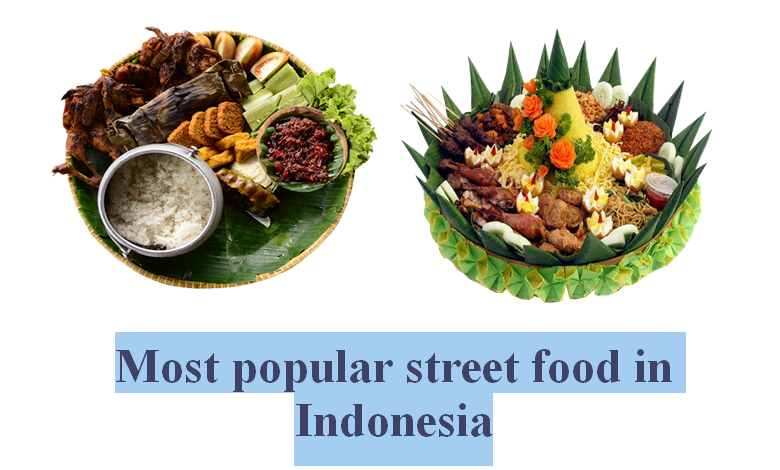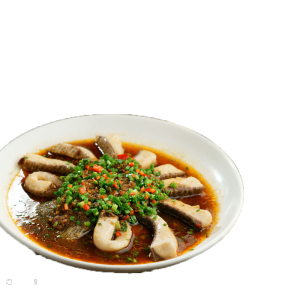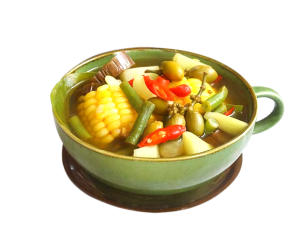What is the most popular street food in Indonesia? Advantages and Disadvantages:
Most popular street food in Indonesia

Most popular street food in Indonesia:
In Indonesia, nasi goreng is frequently regarded as the most well-liked street meal. Usually cooked with kecap manis (sweet soy sauce), shallots, garlic, tamarind, ground shrimp paste, and chile, it is a savory fried rice meal that may also include fried eggs, prawns, chicken, or beef. Slices of cucumber, fried shallots, and krupuk (crisp shrimp or fish crackers) are frequently used as garnish.
Other well-liked Indonesian street dishes are:
- Satay (Sate): Meat that has been skewered and is grilled frequently with peanut sauce.
- Bakso: soup with beef, chicken, or fish meatballs.
- Martabak: Usually loaded with eggs, minced meat, and seasonings, fried stuffed pancakes.
- Gado-gado: a salad containing tofu, tempeh, and a variety of veggies, topped with a peanut sauce dressing.
- Rendang: Rendang is a dish that was once only eaten in Padang but is now enjoyed all over Indonesia. A combination of lemongrass, galangal, garlic, turmeric, ginger, and chilies are slow-cooked with beef in this hot meal.
- Ketoprak: a tofu, rice cake, and rice vermicelli dish for vegetarians that is served with peanut sauce.
- Pempek: A dark, rich, sweet, and tangy sauce is served with the fish cakes.
- Soto: a typical Indonesian dish made with meat—such as chicken, beef, or offal—in a broth flavored with turmeric.
These meals are frequently available and relished as street food throughout Indonesia, however their popularity may vary by area and individual preferences.

Can I eat street food in Indonesia?
In Indonesia, you may unquestionably consume street food. Both natives and visitors appreciate the street food in Indonesia, which is an important component of the country’s culinary tradition. It offers a vast range of tastes, components, and distinctive recipes that are frequently tasty and memorable.
But it’s crucial to proceed with caution and pay attention to good food safety and hygiene procedures, especially while eating street food. Here are some pointers for having a fun and secure time eating Indonesian street food:
- Choose busy and popular vendors: Choose street food sellers that plenty of people in the area go to. A crowded stall frequently signifies that the food is both in high demand and fresh.
- Observe food preparation: If at all feasible, see the handling and preparation of the meal. Make certain that the meal is completely heated and cooked.
- Ensure cleanliness: Verify the kitchen’s cleanliness, the utensils’ cleanliness, and the vendor’s personal hygiene. Cleanliness is essential for preparing meals safely.
- Eat cooked and hot food: Choose cooked food that is hot and freshly prepared. Eat nothing uncooked or undercooked.
- Avoid tap water: Avoid drinking or eating anything produced with tap water, including ice. Opt for bottled or purified water instead.
- Peel fruits and vegetables: Peel fruits and vegetables yourself if you’re eating them raw to lower the chance of contamination.
- Follow local recommendations: Find out from the locals which street food vendors are the most well-liked and secure. They frequently are aware of the safest and best choices.
- Listen to your body: Seek immediate medical assistance if something doesn’t seem right or if you feel sick after eating some street food.
You can take advantage of Indonesia’s wide variety of delectable street food choices while minimizing any potential health concerns by observing these safety rules and exercising your best judgment.

Advantages and Disadvantages:
Although Indonesian street food delivers a distinctive and varied gastronomic experience, it also has its share of benefits and drawbacks like any other type of food.
Advantages:
- Variety and Flavor: The wide variety of tastes and recipes found in Indonesian street food is well known. It offers a taste of traditional Indonesian cuisine with a wide variety of spices and ingredients, from hot rendang to flavorful satay.
- Affordability: Since street food is typically inexpensive, both locals and visitors can afford it. It offers a chance to try out traditional foods without spending a fortune.
- Convenience: Cities and towns frequently have convenient locations for street food booths, offering options for a quick and delectable lunch that are simple to get to.
- Cultural Experience: You can experience the local culture, connect with vendors, and learn about traditional culinary techniques by trying street cuisine.
- Community Interaction: By bringing locals and visitors together to share meals in an outside space, street food frequently fosters a sense of community.
- Local Ingredients: In order to support the neighborhood economy and promote sustainable eating practices, street food vendors frequently use products that are fresh and locally produced.
Disadvantages:
- Hygiene Concerns: The possibility of hygienic problems with street food is one of the main worries. Foodborne infections can result from poor food handling or inadequate cleanliness.
- Food Safety Risks: Street food may be more prone to infection because it is prepared outdoors without sufficient refrigeration, especially in hot and humid settings.
- Limited Seating and Cleanliness: The seating at street food stands is frequently constrained, and there may be a lack of hygienic conditions, such as access to sanitary restrooms and handwashing stations.
- Allergies and Dietary Restrictions: It may be difficult for people with allergies or special dietary needs to determine the components used in street food, or they may only have a few selections that satisfy those criteria.
- Communication Barriers: Communication of food preferences and inquiries regarding the cooking method or ingredients may be hampered by language problems.
- Environmental Impact: If suitable trash disposal facilities are absent, the usage of disposable plates, cups, and food packaging for street food can add to waste and environmental pollution.


Exercise caution, pick trustworthy vendors, place a high priority on cleanliness and hygiene, and be aware of any dietary restrictions or health issues you may have if you want to get the most out of your street food experience in Indonesia.


